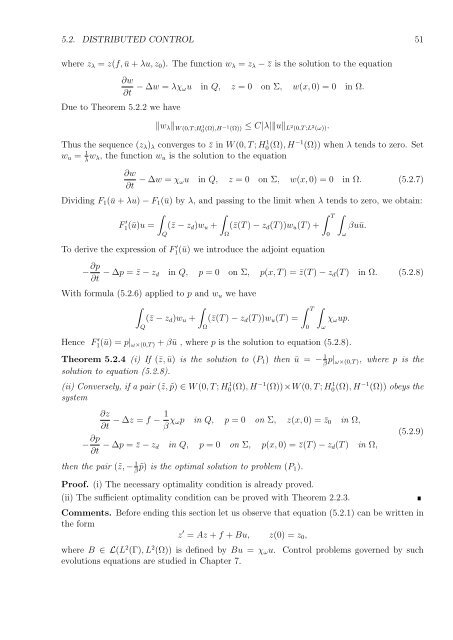Optimal Control of Partial Differential Equations
Optimal Control of Partial Differential Equations
Optimal Control of Partial Differential Equations
You also want an ePaper? Increase the reach of your titles
YUMPU automatically turns print PDFs into web optimized ePapers that Google loves.
5.2. DISTRIBUTED CONTROL 51<br />
where zλ = z(f, ū + λu, z0). The function wλ = zλ − ¯z is the solution to the equation<br />
Due to Theorem 5.2.2 we have<br />
∂w<br />
∂t − ∆w = λχωu in Q, z = 0 on Σ, w(x, 0) = 0 in Ω.<br />
wλ W (0,T ;H 1 0 (Ω),H −1 (Ω)) ≤ C|λ|u L 2 (0,T ;L 2 (ω)).<br />
Thus the sequence (zλ)λ converges to ¯z in W (0, T ; H 1 0(Ω), H −1 (Ω)) when λ tends to zero. Set<br />
wu = 1<br />
λ wλ, the function wu is the solution to the equation<br />
∂w<br />
∂t − ∆w = χωu in Q, z = 0 on Σ, w(x, 0) = 0 in Ω. (5.2.7)<br />
Dividing F1(ū + λu) − F1(ū) by λ, and passing to the limit when λ tends to zero, we obtain:<br />
F ′ <br />
<br />
T <br />
1(ū)u = (¯z − zd)wu + (¯z(T ) − zd(T ))wu(T ) + βuū.<br />
Q<br />
To derive the expression <strong>of</strong> F ′ 1(ū) we introduce the adjoint equation<br />
Ω<br />
− ∂p<br />
∂t − ∆p = ¯z − zd in Q, p = 0 on Σ, p(x, T ) = ¯z(T ) − zd(T ) in Ω. (5.2.8)<br />
With formula (5.2.6) applied to p and wu we have<br />
<br />
<br />
(¯z − zd)wu + (¯z(T ) − zd(T ))wu(T ) =<br />
Q<br />
Ω<br />
T<br />
0<br />
<br />
ω<br />
0<br />
ω<br />
χωup.<br />
Hence F ′ 1(ū) = p|ω×(0,T ) + βū , where p is the solution to equation (5.2.8).<br />
Theorem 5.2.4 (i) If (¯z, ū) is the solution to (P1) then ū = − 1<br />
β p|ω×(0,T ), where p is the<br />
solution to equation (5.2.8).<br />
(ii) Conversely, if a pair (˜z, ˜p) ∈ W (0, T ; H 1 0(Ω), H −1 (Ω))×W (0, T ; H 1 0(Ω), H −1 (Ω)) obeys the<br />
system<br />
∂z<br />
∂t<br />
− ∆z = f − 1<br />
β χωp in Q, p = 0 on Σ, z(x, 0) = ¯z0 in Ω,<br />
− ∂p<br />
∂t − ∆p = ¯z − zd in Q, p = 0 on Σ, p(x, 0) = ¯z(T ) − zd(T ) in Ω,<br />
then the pair (˜z, − 1 ˜p) is the optimal solution to problem (P1).<br />
β<br />
Pro<strong>of</strong>. (i) The necessary optimality condition is already proved.<br />
(ii) The sufficient optimality condition can be proved with Theorem 2.2.3.<br />
(5.2.9)<br />
Comments. Before ending this section let us observe that equation (5.2.1) can be written in<br />
the form<br />
z ′ = Az + f + Bu, z(0) = z0,<br />
where B ∈ L(L 2 (Γ), L 2 (Ω)) is defined by Bu = χωu. <strong>Control</strong> problems governed by such<br />
evolutions equations are studied in Chapter 7.

















